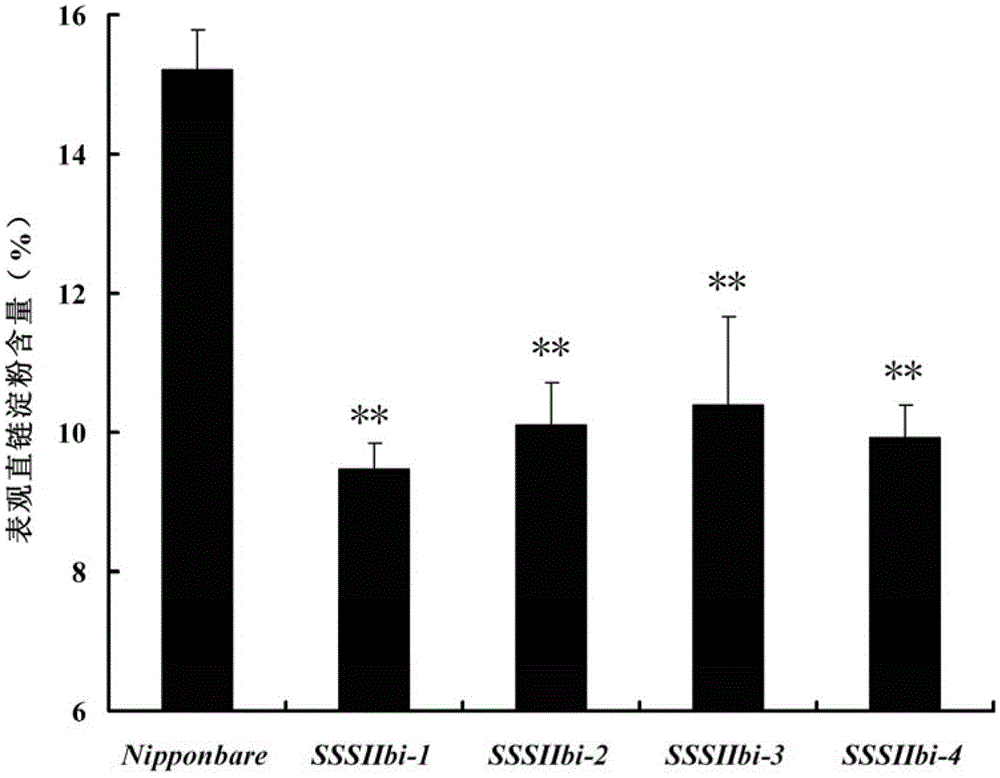A kind of transgenic rice with good eating quality and breeding method
A technology of genetically modified rice and eating quality, applied in botany equipment and methods, plant products, using vectors to introduce foreign genetic material, etc., can solve problems such as functions that have not been reported, and achieve the effect of improving eating quality
- Summary
- Abstract
- Description
- Claims
- Application Information
AI Technical Summary
Problems solved by technology
Method used
Image
Examples
Embodiment 1
[0026] Obtaining of Example 1 DNA Sequence and Construction of RNA Interference Vector
[0027] According to the whole genome information of rice, after obtaining the coding sequence of SSSIIb, the homology of this gene with other isoforms was compared on the Grammne website. The specific primer SSSIIbi (upstream primer 5'-AGGCTGATCATGTTGAG-3', SEQ ID NO.2; downstream primer 5'-G TGTTGATTTTGTGTTT-3', SEQ ID NO.3) was designed for the amplification of RNA interference fragments. The amplified sequence is shown as SEQ ID NO.1.
[0028] The young rice leaves of Nipponbare were used to extract the total RNA of rice by the cold phenol method. After the purity and concentration of the RNA were detected by gel agarose current and spectrophotometer, 1ul of total RNA was reverse-transcribed. The reverse transcriptase was purchased from Fermentas Company (Product No.: 00082399). Use 1ul of the reverse transcription product as a template, and carry out routine PCR amplification with sp...
Embodiment 2
[0029] Embodiment 2 Cultivation and Identification of Transgenic Rice Containing RNA Interference Vector
[0030] Rice tissue culture and Agrobacterium-mediated transformation procedures are all carried out by the method established in the inventor's laboratory (Liu Qiaoquan, etc., the establishment of the rice high-efficiency transformation system mediated by Agrobacterium tumefaciens, Plant Physiology, 1998,24 (3) :259~271). Using Nipponbare mature embryos as explants, callus was induced on N6D2 medium as the transformation recipient, and the constructed RNA interference construct was introduced into rice callus through Agrobacterium-mediated; co-cultured on co-culture medium N6D2C After 3 days, the callus was transferred to N6D2S1 selection medium for screening for about 14 days, and then screened on N6D2S2 selection medium, and the times and days of selection were adjusted according to the actual growth of the callus. A lot of resistant calli were obtained, and after pre-di...
Embodiment 3
[0032] The quality performance of embodiment 3 transgenic rice rice
[0033] Measure rice amylose content according to the document method issued by the Ministry of Agriculture with the number NY147-88. Accurately weigh 50 mg of rice flour on a ten-thousandth balance and put it into a 50 ml test tube, add 0.5 ml of absolute ethanol to disperse the sample, and then Add 4.5ml of 1.0mol / l NaOH solution and mix well, put in boiling water bath for 20min, cool to room temperature, and distilled water to make up volume. Take 5ml of digestive juice, add it to a 100mL volumetric flask filled with half a bottle of distilled water, then add 1.0ml of 1.0mol / l acetic acid solution to acidify the sample; add 1.5ml of 0.02% iodine solution, dilute to volume with distilled water, and shake well After standing still for 15 minutes; add 0.5ml of 95% ethanol to 4.5ml of 1N NaOH to replace the sample, and prepare a blank solution. Use the blank solution to adjust the zero point of the spectropho...
PUM
 Login to View More
Login to View More Abstract
Description
Claims
Application Information
 Login to View More
Login to View More - R&D
- Intellectual Property
- Life Sciences
- Materials
- Tech Scout
- Unparalleled Data Quality
- Higher Quality Content
- 60% Fewer Hallucinations
Browse by: Latest US Patents, China's latest patents, Technical Efficacy Thesaurus, Application Domain, Technology Topic, Popular Technical Reports.
© 2025 PatSnap. All rights reserved.Legal|Privacy policy|Modern Slavery Act Transparency Statement|Sitemap|About US| Contact US: help@patsnap.com



